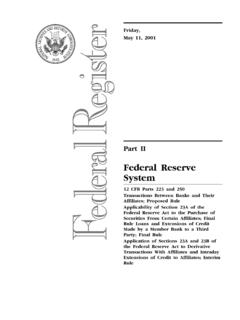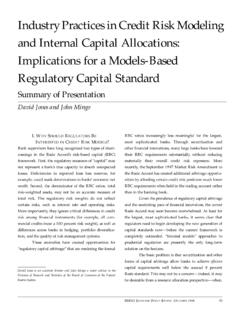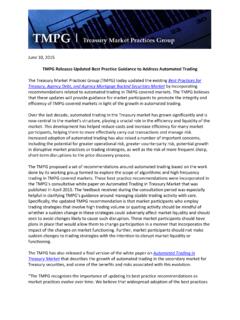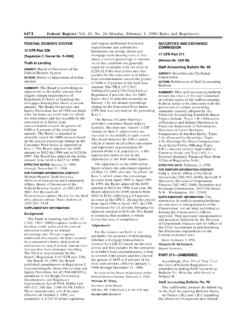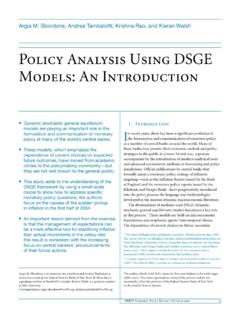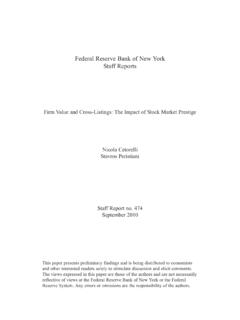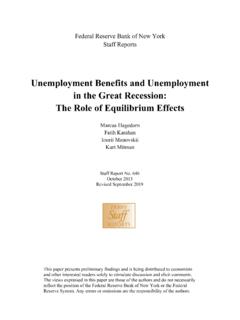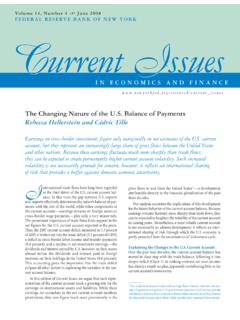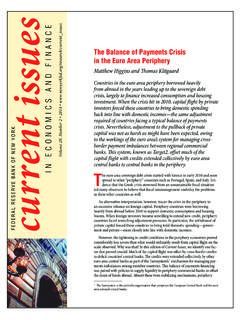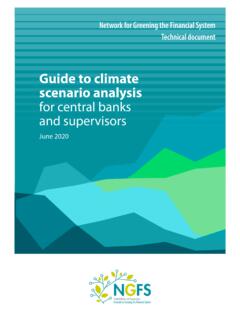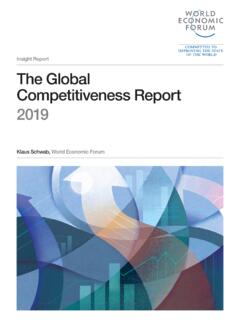Transcription of Climate Stress Testing
1 Climate Stress Testing Hyeyoon Jung | Robert Engle | Richard Berner N O . 977 S E P T E M B E R 2021 Climate Stress Testing Hyeyoon Jung, Robert Engle, and Richard Berner Federal Reserve bank of New York Staff Reports, no. 977 September 2021 JEL classification: Q54, C53, G20 Abstract Climate change could impose systemic risks upon the financial sector, either via disruptions in economic activity resulting from the physical impacts of Climate change or changes in policies as the economy transitions to a less carbon-intensive environment. We develop a Stress Testing procedure to test the resilience of financial institutions to Climate -related risks. Specifically, we introduce a measure called CRISK, systemic Climate risk, which is the expected capital shortfall of a financial institution in a Climate Stress scenario. We use the measure to study the Climate -related risk exposure of large global banks in the collapse of fossil-fuel prices in 2020.
2 Key words: Climate risk, financial stability , Stress Testing _____ Jung: Federal Reserve bank of New York (email: Engle, Berner: Stern School of Business, New York University (email: The authors thank German Gutierrez, Quirin Fleckenstein, Sebastian Hillenbrand, and participants at the Volatility and Risk Institute Conference, EBA EAIA Seminar, and Green Swan Conference for their helpful comments and suggestions. They also thank Georgij Alekseev for excellent research assistance. This paper presents preliminary findings and is being distributed to economists and other interested readers solely to stimulate discussion and elicit comments. The views expressed in this paper are those of the author(s) and do not necessarily reflect the position of the Federal Reserve bank of New York or the Federal Reserve System. To view the authors disclosure statements, visit 1 IntroductionUnderstanding the impact of Climate change on financial systems is an important questionfor researchers, central banks, and financial regulators across the world.))
3 Krueger et al.(2020) find that institutional investors believe Climate risks have financial implications fortheir portfolio firms and that these risks have already begun to materialize. Many centralbanks have recently started including Climate Stress scenarios in their own Stress Network of Central Banks and Supervisors for Greening the FinancialSystem (NGFS), which consists of 89 member countries as of March 2021, analyzes theimpact of Climate change on macroeconomic and financial does Climate change impose systemic risks on the financial sector? Two main chan-nels are: first, through disruptions of economic activity resulting from the physical impactsof Climate change; second, through the changes in policies as economies transition to a lesscarbon-intensive environment. The former are referred to as physical risks and the latter arereferred to as transition risks can affect financial institutions through theirexposures to firms and households that experience extreme weather shocks.
4 On the otherhand, transition risks can affect financial institutions through their exposures to firms withbusiness models not aligned with a low-carbon economy. Fossil fuel firms are a prominentexample: banks that provide financing to fossil fuel firms are expected to suffer when thedefault risk of their loan portfolios increases, as economies transition into a lower-carbonenvironment. If banks systemically suffer substantial losses following an abrupt rise in thephysical risks or transition risks, Climate change poses a considerable risk to the financial1 For example, the central banks and the regulators of Australia, Canada, England, France, and theNetherlands have already begun performing Climate Stress tests, or have announced their intention to conductsuch further details on defines physical risks as financial risks that can be categorized as either acute if they arise fromclimate and weather-related events and acute destruction of the environment or chronic if they arise fromprogressive shifts in Climate and weather patterns or from the gradual loss of ecosystem services.
5 NGFS defines transition risks as financial risks which can result from the process of adjustment towards a lower-carbon and more circular economy, prompted, for example, by changes in Climate and environmental policy,technology, or market sentiment (NGFS (2020)). much systemic risk does Climate change impose on the financial system? Thisquestion is at the heart of understanding the impact of Climate change on financial contribute to answering the question by developing a Climate Stress Testing methodologyto test the resilience of financial institutions to Climate -related risks. Specifically, we developa measure called CRISK, which is the expected capital shortfall of a financial institution ina Climate Stress scenario. The Stress Testing procedure involves three steps. The first stepis to measure the Climate risk factor. While there are many ways to measure the climaterisk factor, we use stranded asset portfolio return as a proxy measure for transition second step is to estimate a time-varying Climate beta of financial institutions usingthe Dynamic Conditional Beta (DCB) model.
6 The third step is to compute CRISK, whichis a function of a given financial firm s size, leverage, and expected equity loss conditionalon Climate Stress . This step is based on the same methodology as SRISK of Acharya etal. (2011), Acharya et al. (2012), and Brownlees and Engle (2017), with the Climate factoradded as the second apply the methodology to measure the Climate risk of 27 large global banks, whoseaggregate oil and gas loan market share exceeds 80%. The Stress scenario that we consideris a 50% drop in the return on stranded asset portfolio over six months. This corresponds tothe first percentile of historical return on stranded asset portfolio. We find that, first, climatebeta varies over time, highlighting the importance of dynamic estimation. Second, climatebetas of banks move together over time, and there was a common spike in Climate betas aswell as in CRISKs when energy prices collapsed in 2020.
7 The measured CRISKs for someof the banks were economically substantial. For instance, Citigroup s CRISK increased by73 billion US dollars during the year 2020. In other words, the expected amount of capitalthat Citigroup would need to raise under the Climate Stress scenario to restore a prudentialcapital ratio4increased by 73 billion US dollars in 2020. In a decomposition analysis, we find4We set prudential capital ratio as 8%.2that the increase in CRISK during 2020 is primarily due to decreases in the equity valuesof banks, as opposed to decreases in debt values or increases in Climate betas. Third, wefind evidence that banks with higher loan exposure to the oil and gas industry tend to havehigher Climate betas, corroborating the economic validity of our Climate beta LiteratureThis paper contributes to several strands of literature. First, it adds to the growing bodyof literature on Climate finance.
8 Giglio et al. (2020) provide a review on the literatureregarding the pricing of Climate risks across different asset classes. Studies including Boltonand Kacperczyk (2020), Engle et al. (2020), and Ilhan et al. (2020) suggest that climaterisks are priced in the equity market. A few papers also have examined the effects of climatechange on banks loan pricing. Chava (2014) finds that banks charge a significantly higherinterest rate on the loans provided to firms with environmental issues. Ginglinger andQuentin (2019) find consistent evidence that greater Climate risk leads to lower leverageafter the Paris Agreement, partly because lenders increase the spreads when lending to firmswith the greatest Climate risk. We add to the literature by quantifying the Climate -relatedrisk exposure of financial institutions. Despite the evidence that banks do price climaterisks, our CRISK measures suggest that Climate change could lead to a substantial increasein systemic risks when transition risks rise paper also contributes to the literature on Stress Testing and systemic risk measure-ment.
9 In the context of Climate -related Stress Testing , Reinders et al. (2020) use Merton scontingent claims model to assess the impact of a carbon tax shock on the value of corpo-rate debt and residential mortgages in the Dutch banking sector. Compared to other stresstesting methodologies, CRISK methodology inherits the benefits of the SRISK methodologyof Acharya et al. (2011), Acharya et al. (2012), and Brownlees and Engle (2017). First,CRISK does not require any proprietary information and can be readily computed usingpublicly available data on the balance sheet and market information of each financial in-3stitution and the return on stranded asset portfolio. Moreover, it can be estimated on ahigh-frequency basis. Therefore, it is very easy to estimate and promptly reflects currentmarket conditions. It is thus a useful monitor that enables regulators to respond in a timelymanner in the case intervention is necessary.
10 Second, CRISK measures the expected capitalshortfall conditional onaggregatestress. That is, we are not measuring how much capital abank would need when the bank is under Stress in isolation. Third, firm-level CRISK can beaggregated to country-level CRISK, which provides early warning signals of macroeconomicdistress due to Climate change. Fourth, by applying a consistent methodology to differentfirms in different countries, the CRISK measure allows comparison across firms and acrosscountries. Lastly, implementing the CRISK measure offers value incremental to other stresstesting methodologies that are already in place. Previous studies including Acharya et al.(2014) and Brownlees and Engle (2017) show that regulatory capital shortfalls measuredrelative to total assets give similar rankings to SRISK. However, rankings are different whenthe regulatory capital shortfalls are measured relative to risk-weighted assets, and they arealso different from those observed in the European Stress of the PaperThe remainder of the paper proceeds as follows: Section 2 describes the data.
